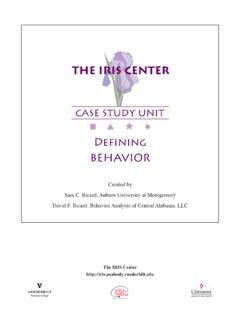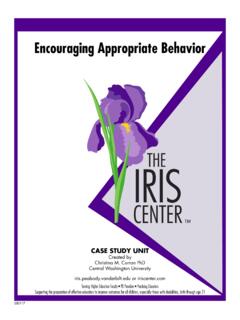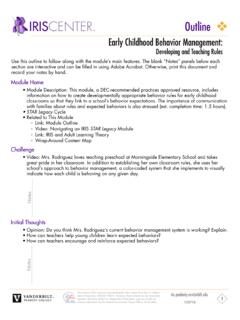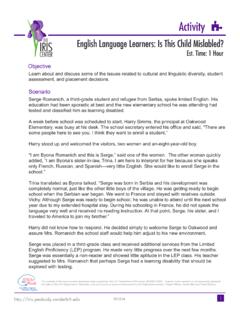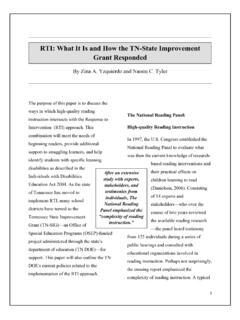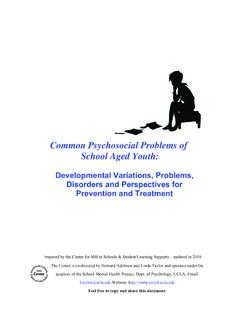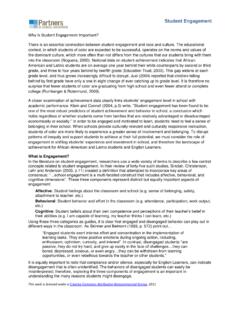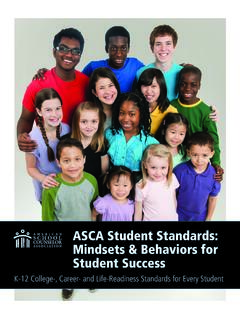Transcription of Establishing Classroom Norms & Expectations
1 032522iris .peabody .vanderbilt .edu or iriscenter .comServing: Higher Education Faculty PD Providers Practicing EducatorsSupporting the preparation of effective educators to improve outcomes for all students, especially struggling learners and those with disabilitiesCASE STUDY UNITE stablishing ClassroomNorms & ExpectationsCreated byCarolyn Evertson, Professor Emeritus, Vanderbilt University & Inge Poole, PhD, Education Consultantiiris .peabody .vanderbilt .eduThe contents of this resource were developed under a grant from the Department of Education, #H325E120002. However, those contents do not necessarily represent the policy of the Department of Education, and you should not assume endorse-ment by the Federal Government. Project Officer, Sarah AllenEstablishing Classroom Norms & ExpectationsContents: PageCredits ..iiStandards ..iiiIntroduction ..ivSTAR Sheets Stating Expectations Clearly.
2 1 Implementing Classroom Rules and Procedures ..3 Supporting Expectations Consistently ..7 Reevaluating Established Norms ..9 Case Studies Level A, Case 1 ..10 Level A, Case 2 ..12 Level B, Case 1 ..13 Level C, Case 1 ..15 Answer Key ..18 TABLE OF CONTENTS* For an Answer Key to this case study, please email your full name, title, and institutional affiliation to the IRIS Center at iris@vanderbilt .edu .iiiris .peabody .vanderbilt .eduiiTo Cite This Case Study UnitEvertson, C ., Poole, I ., & the IRIS Center . (2003) . Establishing Classroom Norms and Expectations . Retrieved from https://iris .peabody .vanderbilt .edu/wp-content/uploads/pdf_case_studies /ics_norms .pdfContent Contributors Carolyn Evertson Inge Poole2003 Case Study DevelopersKim SkowGraphicsErik Duntonpp . 3, 6 Rules Boxes Adapted from Evertson & Harris, 2003; Evertson, Emmer, & Worsham, 2003 Establishing Classroom Norms & ExpectationsCREDITS iiiiris.
3 Peabody .vanderbilt .eduiiiEstablishing Classroom Norms & ExpectationsSTANDARDSL icensure and Content StandardsThis IRIS Case Study aligns with the following licensure and program standards and topic areas . Council for the Accreditation of Educator Preparation (CAEP)CAEP standards for the accreditation of educators are designed to improve the quality and effectiveness not only of new instructional practitioners but also the evidence-base used to assess those qualities in the Classroom . Standard 1: Content and Pedagogical KnowledgeCouncil for Exceptional Children (CEC)CEC standards encompass a wide range of ethics, standards, and practices created to help guide those who have taken on the crucial role of educating students with disabilities . Standard 2: Learning EnvironmentsInterstate Teacher Assessment and support Consortium (InTASC)InTASC Model Core Teaching Standards are designed to help teachers of all grade levels and content areas to prepare their students either for college or for employment following graduation.
4 Standard 3: Learning Environments National Council for Accreditation of Teacher Education (NCATE)NCATE standards are intended to serve as professional guidelines for educators . They also overview the organizational structures, policies, and procedures necessary to support them . Standard 1: Candidate Knowledge, Skills, and Professional DispositionsThe Division for Early Childhood Recommended Practices (DEC)The DEC Recommended Practices are designed to help improve the learning outcomes of young children (birth through age five) who have or who are at-risk for developmental delays or disabilities . Topic 3: Environment Topic 5: Instruction iviris .peabody .vanderbilt .eduivThis case study set focuses on the establishment of Classroom Norms and Expectations . This introduction offers an overview of Norms and Expectations and how they are communicated and established in a Classroom .
5 To establish Norms and Expectations in a Classroom is a complex, long-term task . Your skill in successfully undertaking it will evolve as you become more experienced . The goal of this case study set is to help you understand how to prevent many problem behaviors by putting supportive Classroom structures in place as you set up an effective Classroom .What is an effective Classroom ? It is one that runs smoothly, with minimal confusion and down time, and maximizes student learning . An effective Classroom has patterns and routines in place that make interaction and movement within that Classroom easy to organize and accomplish . Such patterns and routines are established through the development of Classroom rules and procedures . Rules are the explicit statements of teacher s Expectations for students behavior in a Classroom . Procedures are the patterns for accomplishing Classroom tasks.
6 Teachers communicate their Expectations to students through the development and enactment of both . Expectations are desired behaviors or outcomes . Within a Classroom , a teacher can make his or her Expectations known to students, or the teacher can cause students to guess at the Expectations . It is much easier for students to meet a teacher s Expectations when they know what these Expectations are . Teachers can make their Expectations known to students by directly teaching the Classroom rules and procedures, providing opportunities for the students to practice them, and consistently responding to students behavior . A teacher s consistent responses can include both positive consequences to reinforce a student s appropriate behavior and negative consequences to deter a student s inappropriate behavior .Students also have Expectations for their own behavior . When the behavior that the teacher and students expect and exhibit becomes so routine that it seems to be in consensus, a Classroom norm for that behavior has been established.
7 Norms can be defined as accustomed ways of perceiving, believing, evaluating, and acting in an environment (Goodnough, 1971) . In other words, Norms are the familiar ways we have of interacting with each other in a particular setting . Establishing Classroom Norms & ExpectationsINTRODUCTION viris .peabody .vanderbilt .eduvCase Study Set DefinitionsNorms familiar ways of interacting in a classroomExpectations desired behaviors or outcomesRules written Expectations for behavior in a classroomProcedures patterns for accomplishing Classroom tasksWithin classrooms, a common norm for requesting a turn to speak during instruction is to raise one s hand and wait to be acknowledged . This Classroom norm develops when a teacher teaches his or her students how to raise their hands when they want to speak, has students practice raising their hands, and consistently responds to students behavior (positively when they raise their hands, and negatively when they don t).
8 In fact, this norm often becomes so familiar it is used in other settings have you ever raised your hand for a turn to speak at the dinner table? Whereas Classroom Norms , such as raising one s hand, are sustained by consensus, they can also be suspended or changed if they are not supported or reinforced . For example, a norm for being in class on time ceases to be a norm when there is no consequence for students tardiness . Thus, arriving late becomes the accepted practice . The actions and interactions that a teacher encourages or allows to become familiar develop into that Classroom s Norms . Therefore, thoughtful advance planning by the teacher can guide and establish effective group Norms that support student learning .For example, prompt attendance promotes student learning by making certain that students are exposed to as much instructional time as possible.
9 Therefore, a teacher might require prompt attendance as well establish procedures to make prompt attendance a familiar routine . A Classroom rule regarding prompt attendance might be stated as Be in your seat and ready for class when the bell rings . A procedure involved in preparing for class might require students to place their completed homework in a designated location as they enter the Classroom . When all the procedures of preparing for class prior to the bell s ring become routine for students, prompt attendance has become an established Classroom norm .Ultimately, a teacher wants to establish Classroom Norms that create an effective Classroom in which student learning time is maximized . In this case study set, we will consider four specific aspects of Establishing Classroom Norms and Expectations : 1 . Stating Expectations clearly, 2 . Implementing Classroom rules and procedures, 3.
10 Supporting Expectations consistently, and 4 . Reevaluating established Norms .What the Research and Resources Say Teachers who establish and maintain Norms for an effective learning environment spend more time teaching because less time is usurped by discipline (Brophy, 2000) . Norms that engender a supportive learning environment include acting and interacting responsibly, treating others with respect and concern, and fostering a learning orientation (Brophy 1998; 2000; Good & Brophy, 2000; Sergiovanni, 1994) . Effective school - wide Norms can be established through a school -based program that focuses on supportive interactions among students (Solomon, Watson, Delucchi, Schaps, & Battistich, 1988) .viiris .peabody .vanderbilt .eduvi What a STAR Sheet a STAR Sheet STAR (STrategies And Resources) Sheet provides you with a description of a well-researched strategy that can help you solve the case studies in this unit.
